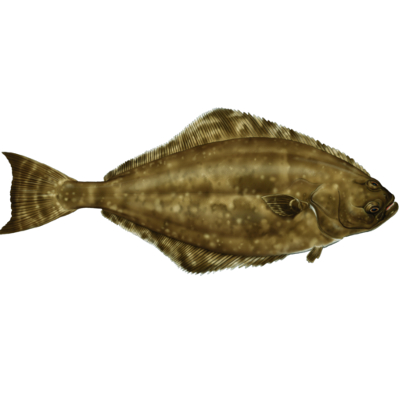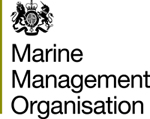

A giant of the flatfish world! Atlantic halibut are not mature until they are 1.4 metres in length (4.5 feet) and are aged between 10 and 14 years old. They can grow to a massive 4.7metres (15 feet long) and weigh more than 300kg but there are very few left in our waters so are not recommended as sustainable.
The majority of halibut offered for sale are farmed outside Cornwall. Wild Atlantic halibut are only rarely landed to Cornish ports as they are extremely rare and the victims of over-fishing. the majority of those caught are immature being significantly smaller in size than when mature, therefore removing their potential contribution towards stock recovery. Additionally, demersal trawl gear has significant potential for damaging the seabed and benthic habitats. Trawling is also associated with discarding of unwanted fish, i.e. undersized and/or non-quota and/or over-quota species. We recommend you choose a recommended Cornish alternative such as Hake, Brill or Megrim.
Cornwall
Halibut are overfished and rare in our waters. They are rarely landed to Cornwall. This species is listed as one to avoid.
Learn moreCornwall Good Seafood Guide rates fish on sustainability using a scale of 1 to 5.
1, 2 and 3 are recommended, Fish to avoid are rated 5.
We use the system devised by the Marine Conservation Society (MCS) so our scores are comparable with the scores produced by MCS for the UK and fisheries from all around the world. For more information on scoring click here.
Atlantic halibut, the largest of all flat fishes, is a thick-set, right-eyed (both eyes on the right-hand side of the body) flat fish related to plaice and flounder. It is distributed throughout the north Atlantic, particularly Norway, Faroes, Iceland and southern Greenland, but occurs as far south as Maine in north America and the Bay of Biscay in Europe. It can attain a length of 4.7m and more than 300kg, but it is considered slow growing in the wild. Spawning occurs during winter and early spring. Atlantic halibut become sexually mature at 10-14 years, at around 1.4m in length. The oldest recorded halibut has been 55 years of age yet models indicate that they could live for nearly 100 years! It has been a heavily targeted fishery for more than 100 years and with slow growth rates, high age at maturity and a population doubling time of around 14 years, is highly susceptible to overfishing. IUCN list Atlantic halibut as Endangered (1996) and the species appears on the US National Marine Fisheries Service list of species of concern. Additionally the Project Inshore Phase II Report (2013) noted that under the MSC Risk Based Framework, the species was ranked as the 6th most susceptible species, behind some sharks and rays.
NE Atlantic halibut stocks are not assessed by ICES nor are they sufficiently researched at the local or national level to determine biological or fishery reference points. There are no harvest control rules or long term management plans in place for the fishery nor a Minimum Landing Size (MLS) within the EU. The only targted fisheries in the NE Atlantic occur in the waters around Greenland yet the species are continued to be landed as bycatch in trawl, gill net and demersal long line fisheries. In 2013 the EU Council further reduced the Total Allowable Catch (TAC) down to 112t for each of the areas around Greenland - ICES Areas V, XIV and in NAFO Areas 0 & 1. In Iceland, there is a ban on all directed fisheries and all live halibut caught with a chance of post capture survival are to be released. In Norwegian coastal waters, north of 62 degrees, there are some directed long line fisheries that are reportedly tightly controlled. Stocks are also reportedly increasing in Norwegian waters, yet there is insufficient information available to assess the health of this fishery or to justify treating it independently from the rest of the NE Atlantic. ICES have previously recommended that there should be no directed fishery for Atlantic halibut in the NE Atlantic and there have been no further updates, advice or research to suggest otherwise. For UK fisheries, Project Inshore Phase II Report (2013) noted that there are no harvest control rules nor are there any tools available to implement harvest control rules for Atalantic halibut.
There are no specific managment measures for halibut in our area.
Halibut are caught by demersal trawls and occasionally are caught in tangle nets around the Cornish Coast. There is no directed fishery for this species and rare catched are made as accidental by catch, usually of immature specimens.






Cornwall Good Seafood Guide is underpinned by the Marine Conservation Society (MCS) Good Fish Guide. The first UK consumer guide to sustainable seafood. For more information visit www.fishonline.org
Cornwall Good Seafood Guide is here to help us all make sustainable seafood choices. Choices that will help us keep the oceans healthy and Cornish fishers' futures safe. This website is funded by Cornwall Wildlife Trust. If you would like to make a meaningful difference to the health of our oceans, please consider making a donation to the Cornwall Wildlife Trust Ocean Emergency fund. Your donation will help safeguard these remarkable environments, ensuring that they continue to thrive for generations to come. Together, we can be stewards of the seas and champions for a healthier, more sustainable future.